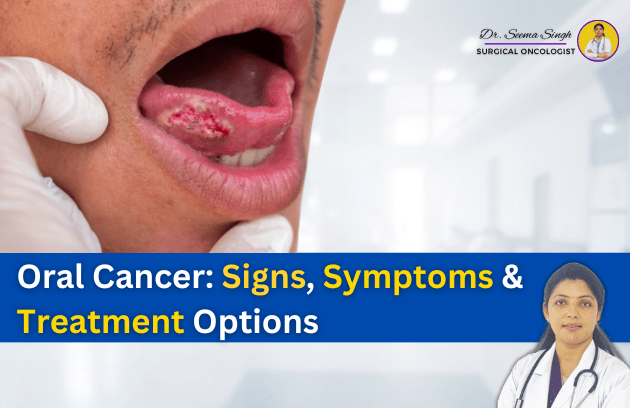- December 15, 2023
- Dr Seema Singh
- Comment: 0
- Uncategorized
What is Mouth Cancer?
Mouth cancer, also known as oral cancer, is a general term for cancer that impacts the inside of your mouth. Signs of oral cancer might seem like usual issues with your lips or mouth, such as white patches or sores that bleed. The key difference between a regular problem and possible cancer is that these changes persist and don’t go away. If not treated, mouth cancer can spread to different parts of your mouth, throat, and other areas in your head and neck.
How does mouth cancer impact my body?
Mouth cancer can impact both your mouth and your oropharynx. The oropharynx includes areas like your tongue, the roof of your mouth, and the middle part of your throat that you can see when your mouth is open wide. When cancer occurs in your oropharynx, it’s known as oropharyngeal cancer. This article specifically discusses oral cancer within your mouth, also called the oral cavity.
What parts are in my mouth?
- Lips
- Gums
- The inside lining of your cheeks
- The front two-thirds of your tongue
- The floor beneath your tongue
- The initial section of the roof of your mouth
- The space just behind your wisdom teeth
What leads to mouth cancer?
Mouth cancer begins in the flat squamous cells within your oral cavity. These cells, when examined under a microscope, resemble fish scales.
When the DNA in normal squamous cells undergoes changes, they can become cancerous, causing them to grow and multiply. Over time, these cancerous cells may spread to other parts within your mouth and eventually to different areas in your head, neck, or other parts of your body.
What are the symptoms of mouth cancer?
Mouth cancer shows various signs that might be confused with common issues or changes in your mouth. For instance, you might observe patches inside your mouth that you can’t scrape away, and these patches could indicate pre-cancerous conditions.
There are different colored patches in your mouth and throat, signifying various conditions:
Leukoplakia: Flat white or gray patches.
Erythroplakia: Slightly raised or flat red patches that may bleed when scraped.
Erythroleukoplakia: Patches that are both red and white.
Common signs and symptoms of oral cancer include:
- Sores on your lip or inside your mouth that bleed easily and don’t heal within two weeks.
- Rough spots or crusty areas on your lips, gums, or inside your mouth.
- Areas in your mouth that bleed for no obvious reason.
- Numbness, pain, or tenderness on your face and neck or in your mouth without an apparent cause.
- Difficulty chewing or swallowing, speaking, or moving your jaw or tongue.
- Unintentional weight loss.
- Chronic bad breath.
What are other ways to treat mouth cancer?
Healthcare providers might combine surgery with other treatments, such as:
- Radiation therapy: This treatment uses powerful beams of energy to eliminate or slow down the growth of cancer cells. It can be combined with other treatments.
- Targeted therapy: This cancer treatment employs drugs or substances to specifically identify and attack certain types of cancer cells without harming normal cells. Monoclonal antibodies, which are immune system proteins created in the lab, may be used in this treatment.
- Chemotherapy: Anti-cancer drugs that kill cancer cells, affecting various parts of the body, may be used as part of the treatment plan.
- Immunotherapy: This cancer treatment activates your immune system to combat the disease. Sometimes, it’s referred to as biological therapy.
When should I get in touch with my healthcare provider?
Reach out to your healthcare provider whenever you observe changes in your mouth, like new sores or rough spots that persist for more than two weeks. You can Consult Dr. Seema Singh who is the Best Cancer specialist for treating Mouth Cancer.


